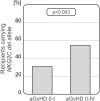Significance of HLA-E and its two NKG2 receptors in development of complications after allogeneic transplantation of hematopoietic stem cells
- PMID: 37901227
- PMCID: PMC10611459
- DOI: 10.3389/fimmu.2023.1227897
Significance of HLA-E and its two NKG2 receptors in development of complications after allogeneic transplantation of hematopoietic stem cells
Abstract
Transplantation of hematopoietic stem cells (HSCT) is a procedure commonly used in treatment of various haematological disorders which is associated with significantly improved survival rates. However, one of its drawbacks is the possibility of development of post-transplant complications, including acute and chronic graft-versus-host disease (GvHD) or CMV infection. Various studies suggested that NK cells and their receptors may affect the transplant outcome. In the present study, patients and donors were found to significantly differ in the distribution of the NKG2A rs7301582 genetic variants - recipients carried the C allele more often than their donors (0.975 vs 0.865, p<0.0001). Increased soluble HLA-E (sHLA-E) levels detected in recipients' serum 30 days after transplantation seemed to play a prognostic and protective role. It was observed that recipients with higher sHLA-E levels were less prone to chronic GvHD (11.65 vs 6.33 pg/mL, p=0.033) or more severe acute GvHD grades II-IV (11.07 vs 8.04 pg/mL, p=0.081). Our results also showed an unfavourable role of HLA-E donor-recipient genetic incompatibility in CMV infection development after transplantation (OR=5.92, p=0.014). Frequencies of NK cells (both CD56dim and CD56bright) expressing NKG2C were elevated in recipients who developed CMV, especially 30 and 90 days post-transplantation (p<0.03). Percentages of NKG2C+ NK cells lacking NKG2A expression were also increased in these patients. Moreover, recipients carrying a NKG2C deletion characterized with decreased frequency of NKG2C+ NK cells (p<0.05). Our study confirms the importance of NK cells in the development of post-transplant complications and highlights the effect of HLA-E and NKG2C genetic variants, sHLA-E serum concentration, as well as NKG2C surface expression on transplant outcome.
Keywords: HLA-E; HSCT; NK cell receptors; NK cells; NKG2A; NKG2C; sHLA-E; transplant outcome.
Copyright © 2023 Siemaszko, Łacina, Szymczak, Szeremet, Majcherek, Czyż, Sobczyk-Kruszelnicka, Fidyk, Solarska, Nasiłowska-Adamska, Skowrońska, Bieniaszewska, Tomaszewska, Basak, Giebel, Wróbel and Bogunia-Kubik.
Conflict of interest statement
The authors declare that the research was conducted in the absence of any commercial or financial relationships that could be construed as a potential conflict of interest.
Figures










References
-
- Bate SL, Dollard SC, Cannon MJ. Cytomegalovirus seroprevalence in the United States: the national health and nutrition examination surveys, 1988-2004 Vol. 50. Clinical infectious diseases: an official publication of the Infectious Diseases Society of America; (2010) p. 1439–47. doi: 10.1086/652438 - DOI - PMC - PubMed
-
- Wei-Lu, Chen SJ, Huang SF, Chan YJ, Wang FD, Chen HP. Clinical significance of human cytomegalovirus viruria and the effect of antiviral therapy in hematopoietic stem cell transplant recipients. J Microbiol Immunol Infect = Wei Mian Yu Gan Ran Za Zhi (2019) 52(3):402–8. doi: 10.1016/j.jmii.2017.08.019 - DOI - PubMed
Publication types
MeSH terms
Substances
LinkOut - more resources
Full Text Sources
Medical
Molecular Biology Databases
Research Materials

